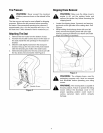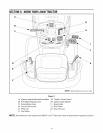
Startingthe Engine
_, WARNING: Do not operate the tractor ifthe
interlock system is malfunctioning. This
system was designed for your safety and
protection.
NOTE: Refer to the TRACTORSET-UPon page 10 of this
manual for Gasoline and Oil fill-up instructions.
1. Insert the tractor key into the ignition switch
module.
2. Place the PTO (Blade Engage) lever in the
disengaged (OFF) position.
3. Engage the tractor's parking brake.
4. Activate the choke control.
5. Turn the ignition key clockwise to the START
position. After the engine starts, release the key. It
will return to the NORMAL MOWING position.
IMPORTANT: Do NOT hold the key in the START
position for longer than ten seconds at a time. Doing so
may cause damage to your engine's electric starter.
6. After the engine starts, deactivate the choke
control.
NOTE: Do NOT leave the choke control on while
operating the tractor. Doing so will result in a "rich" fuel
mixture and cause the engine to run poorly.
Stoppingthe Engine
WARNING: If you strike a foreign object,
stop the engine and remove the ignition key.
Thoroughly inspect the machine for any
damage. Repair the damage before restarting
and operating
1. If the blades are engaged, place the PTO/Blade
Engage lever in the disengaged (OFF) position.
2. Position the throttle/choke control between half-
throttle and the FAST (rabbit) position
3. Turn the ignition key counterclockwise to the STOP
position.
4. Remove the key from the ignition switch to prevent
unintended starting.
1. Depress the brake pedal to release the parking
brake and let the pedal up.
2. Move the throttle/choke control into the FAST
(rabbit) position.
IMPORTANT:Do NOT use the shift lever to change the
direction of travel when the tractor is in motion. Always
use the brake pedal to bring the tractor to a complete
stop before shifting.
3. To move forward, place the shift lever in the
FORWARD position, then slowly depress the drive
pedal until the desired speed is achieved.
4. To move in reverse, place the shift lever in the
REVERSE position, check that the area behind is
clear then slowly depress the drive pedal.
DrivingOnSlopes
Refer to the SLOPEGAUGEon page 9 to help determine
slopes where you may operate the tractor safely.
_, ARNING: Do not mow on inclines with a
slope in excess of 15 degrees (a rise of
approximately 2-1/2 feet every 10 feet). The
tractor could overturn and cause serious
injury.
• Mow up and down slopes, NEVER across.
• Exercise extreme caution when changing direction
on slopes.
• Watch for holes, ruts, bumps, rocks, or other
hidden objects. Uneven terrain could overturn the
machine. Tall grass can hide obstacles.
• Avoid turns when driving on a slope. If a turn must
be made, turn down the slope. Turning up a slope
greatly increases the chance of a roll over.
• Avoid stopping when driving up a slope. If it is
necessary to stop while driving up a slope, start up
smoothly and carefully to reduce the possibility of
flipping the tractor over backward.
SettingTheCruiseControl
_, ARNING: Never engage cruise control
while traveling in Reverse.
DrivingTheTractor
WARNING: Avoid sudden starts, ex-
cessive speed and sudden stops.
WARNING: Do not leave the seat of the
tractor without first placing the PTO (Blade
Engage) lever in the disengaged (OFF)
position, depressing the brake pedal and
engaging the parking brake. If leaving the
tractor unattended, also turn the ignition key
off and remove the key.
1. Slowly depress the drive pedal until the desired
speed is achieved.
2. Lightly depress the cruise control lever.
3. While continuing to hold the cruise lever down, lift
your foot from the drive pedal (you should feel the
cruise latch engage).
4. Once engaged, the cruise control lever and the
drive pedal will lock in the "down" position, and the
tractor will maintain the same forward speed.
17


















